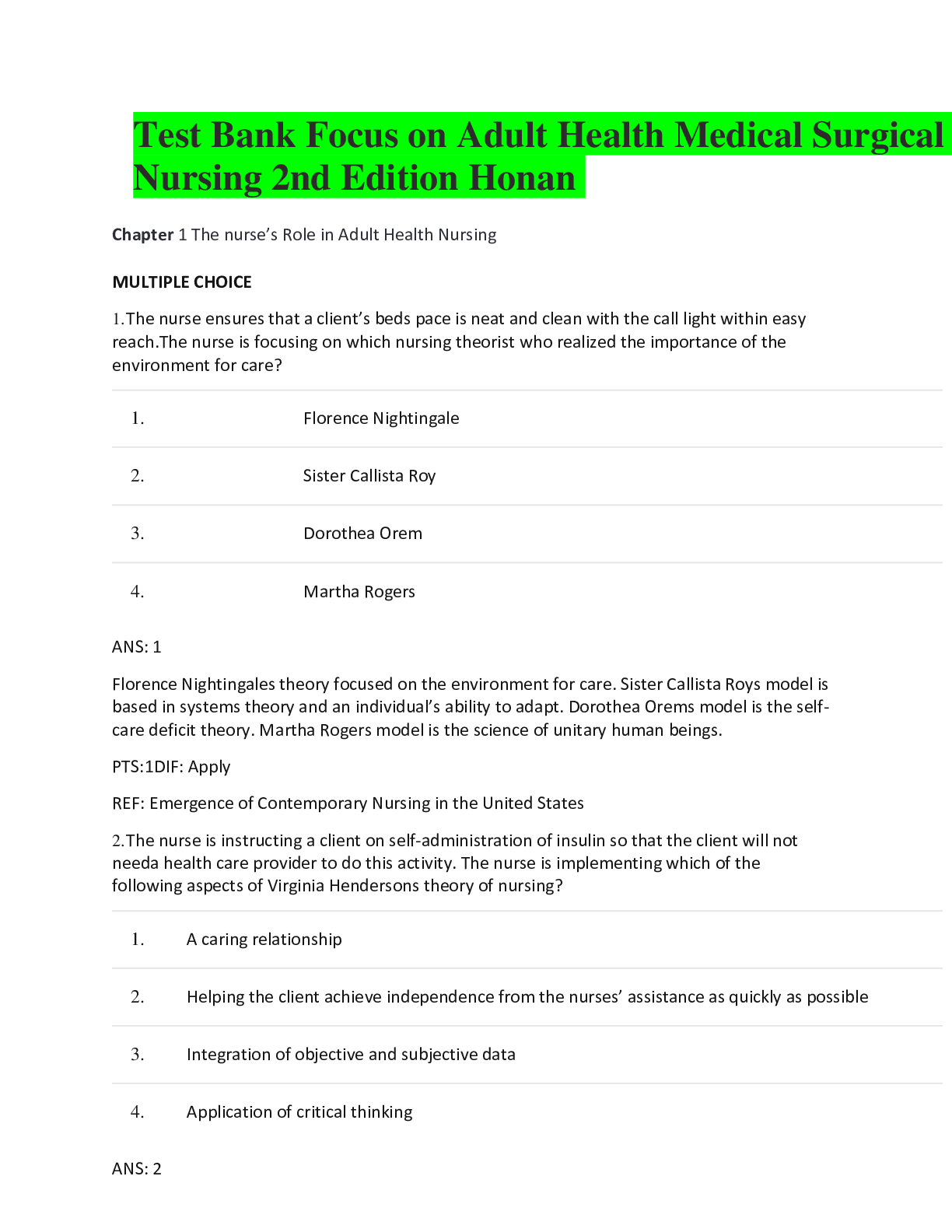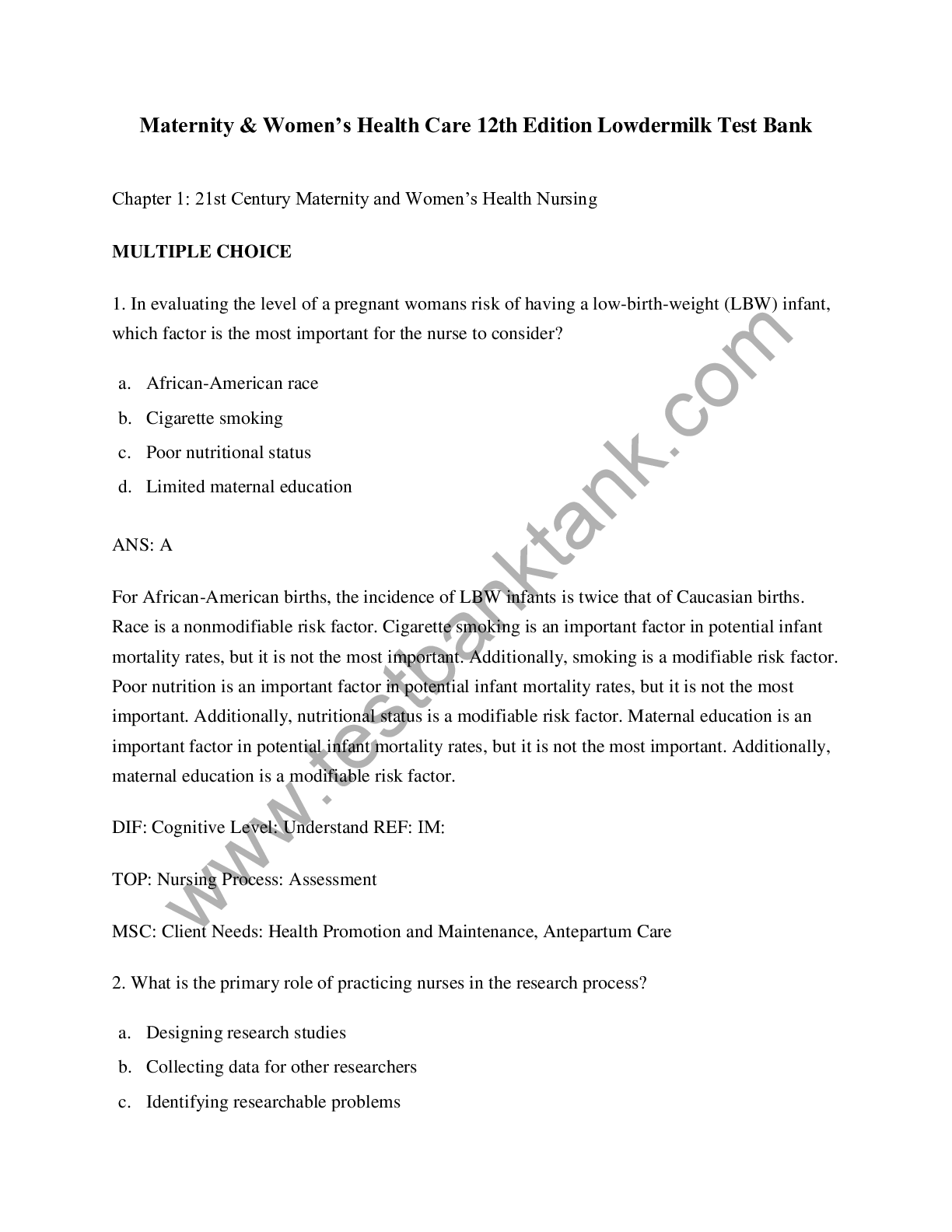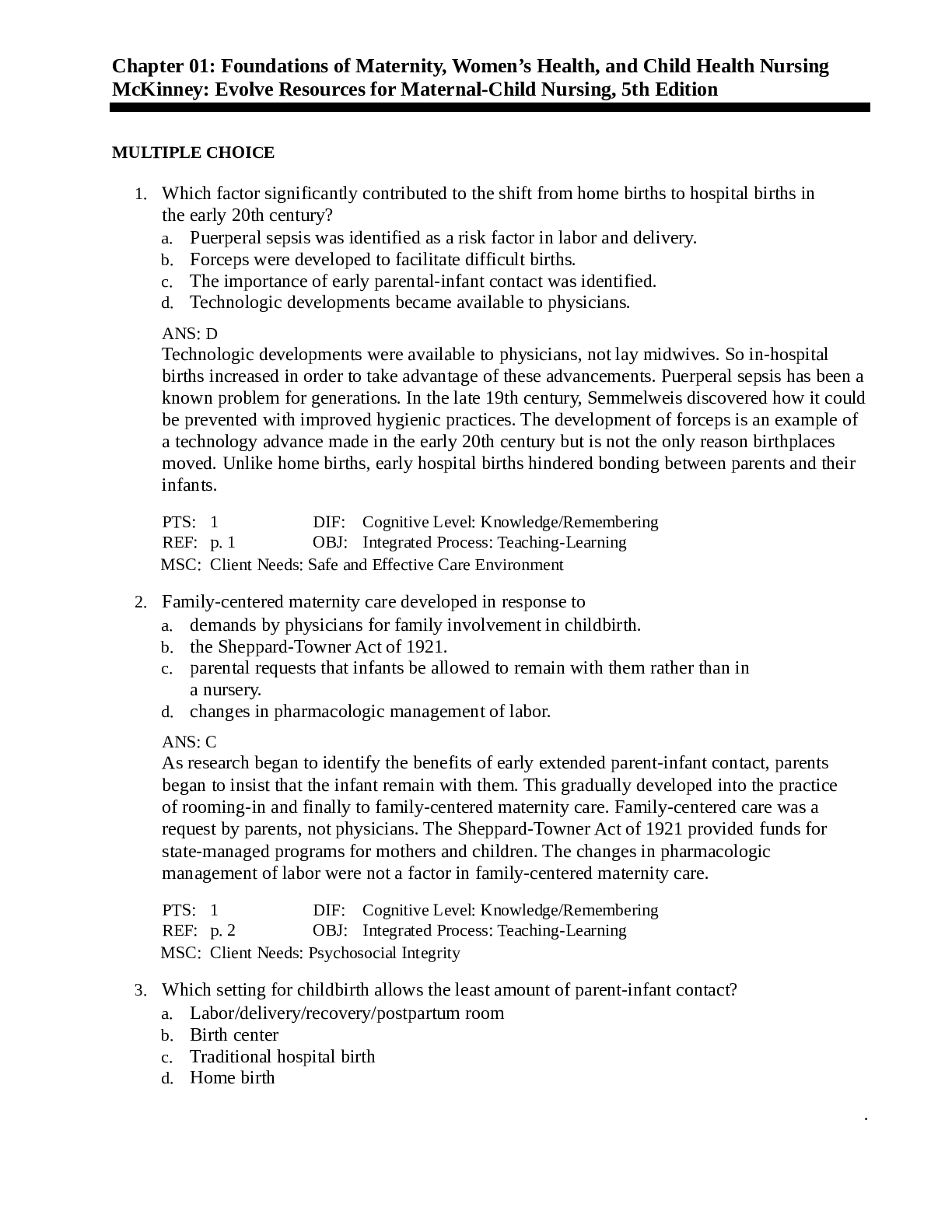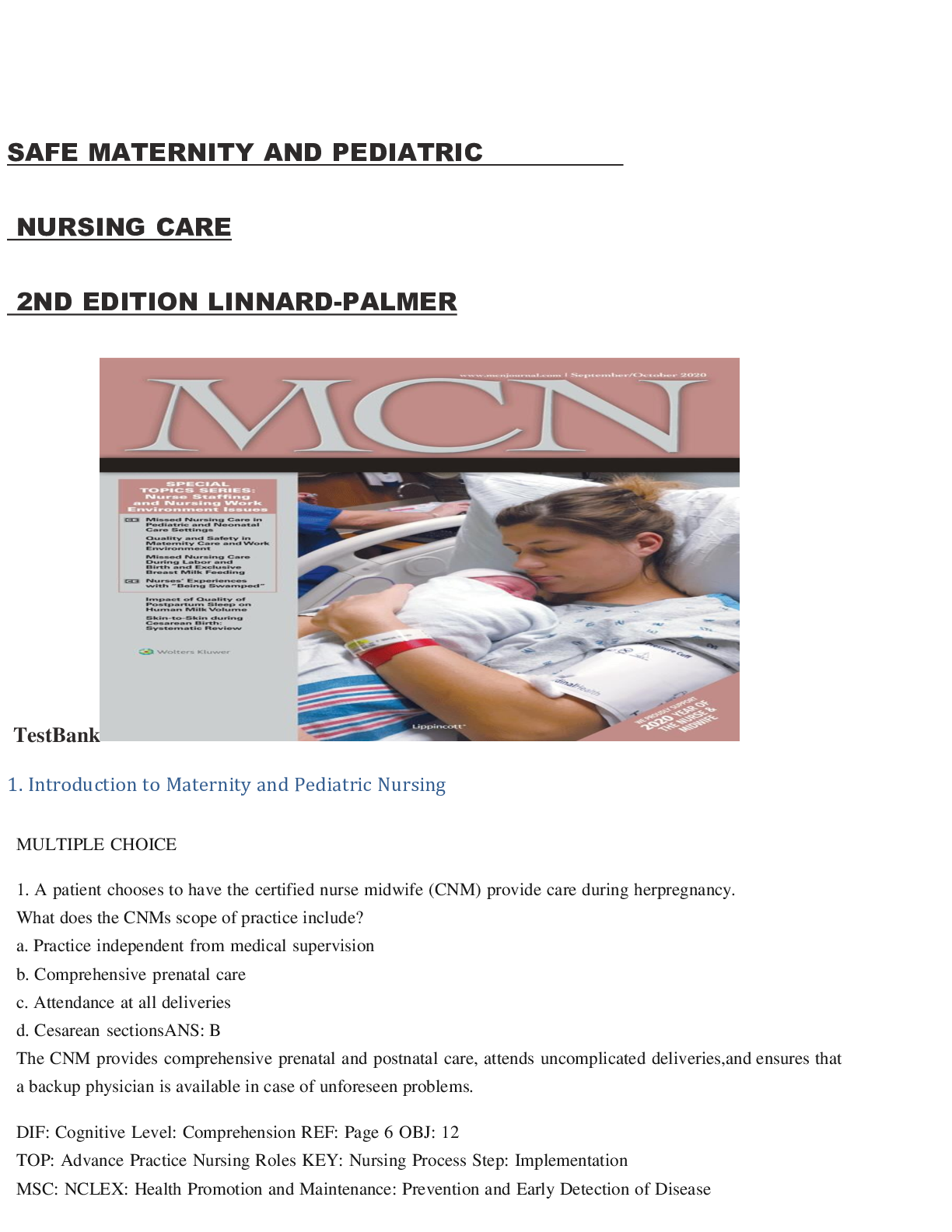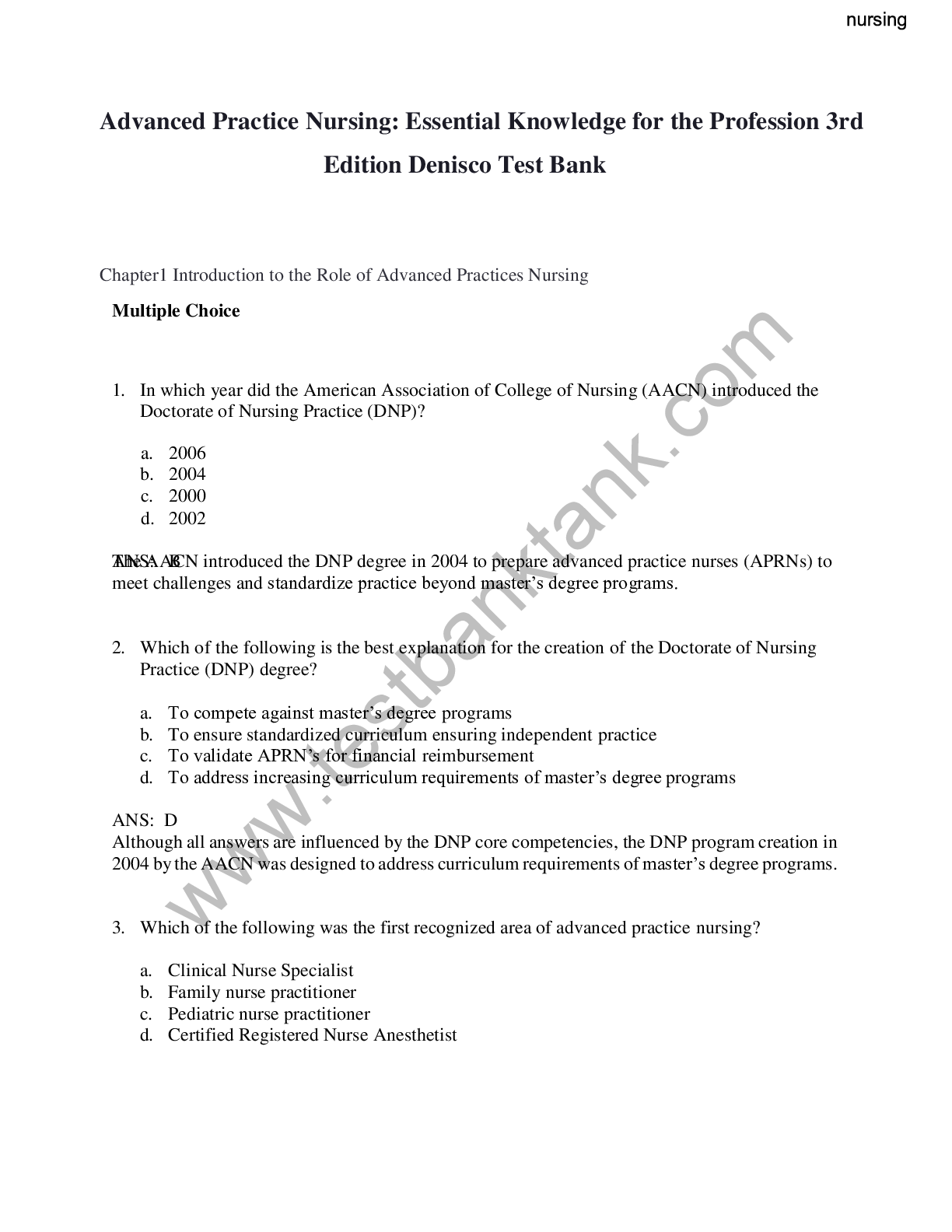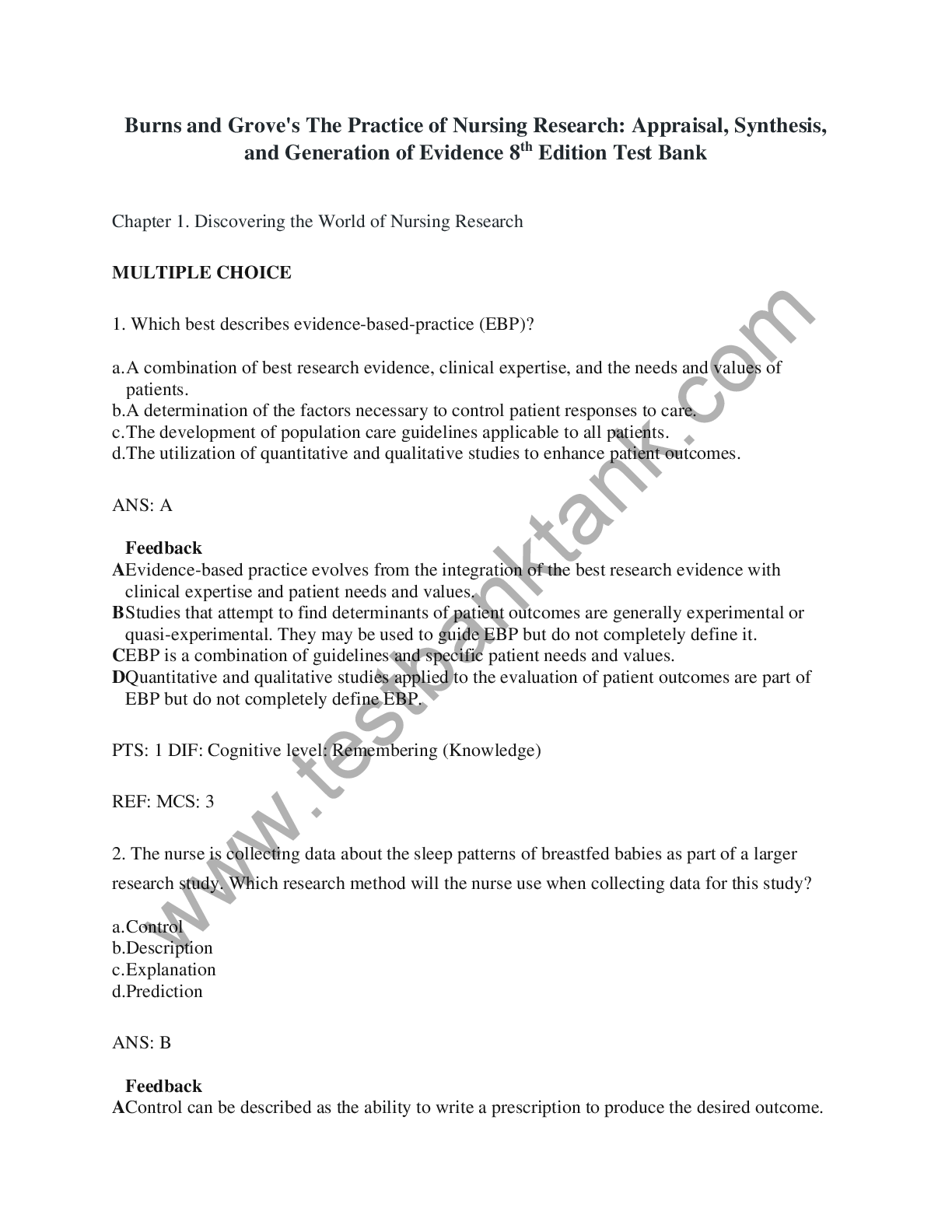*NURSING > TEST BANKS > Jarvis: Evidence-Based Physical Examination Best Practices for Health & Well-Being Assessment 8th Ed (All)
Jarvis: Evidence-Based Physical Examination Best Practices for Health & Well-Being Assessment 8th Edition Test Bank
Document Content and Description Below
MULTIPLE CHOICE 1. After completing an initial assessment of a patient, the nurse has charted that his respirations are eupneic and his pulse is 58 beats per minute. What type of assessment data is ... this? a. Objective b. Reflective c. Subjective d. Introspective ANS: A Objective data is what the health professional observes by inspecting, percussing, palpating, and auscultating during the physical examination. Subjective data is what the person says about him or herself during history taking. The terms reflective and introspective are not used to describe data. DIF: Cognitive Level: Understanding (Comprehension) MSC: Client Needs: Safe and Effective Care Environment: Management of Care 2. A patient tells the nurse that he is very nervous, nauseous, and “feels hot.” What type of assessment data is this? a. Objective b. Reflective c. Subjective d. Introspective ANS: C Subjective data is what the person says about him or herself during history taking. Objective data is what the health professional observes by inspecting, percussing, palpating, and auscultating during the physical examination. The terms reflective and introspective are not used to describe data. DIF: Cognitive Level: Understanding (Comprehension) MSC: Client Needs: Safe and Effective Care Environment: Management of Care 3. What do the patient’s record, laboratory studies, objective data, and subjective data combine to form? a. Database b. Admitting data c. Financial statement d. Discharge summary ANS: A Together with the patient’s record and laboratory studies, the objective and subjective data form the database. The other items are not part of the patient’s record, laboratory studies, or data. Physical Examination and Health Assessment 8th Edition Chapter 1 - Evidence-Based Assessment 4 DIF: Cognitive Level: Remembering (Knowledge) MSC: Client Needs: Safe and Effective Care Environment: Management of Care Physical Examination and Health Assessment 8th Edition Chapter 1 - Evidence-Based Assessment 5 4. When listening to a patient’s breath sounds, the nurse is unsure of a sound that is heard. Which action should the nurse take next? a. Notify the patient’s physician. b. Document the sound exactly as it was heard. c. Validate the data by asking another nurse to listen to the breath sounds. d. Assess again in 20 minutes to note whether the sound is still present. ANS: C When unsure of a sound heard while listening to a patient’s breath sounds, the nurse validates the data to ensure accuracy by either repeating the assessment themselves or asking another nurse to assess the breath sounds. If the nurse has less experience analyzing breath sounds, then he or she should ask an expert to listen. When unsure of a sound heard while listening to a patient’s breath sounds, the nurse should validate the data before documenting to ensure accuracy and before notifying the patient’s physician. To validate that data, the nurse either repeats the assessment himself or herself or asks another nurse to assess the breath sounds. DIF: Cognitive Level: Analyzing (Analysis) MSC: Client Needs: Safe and Effective Care Environment: Management of Care 5. The nurse is conducting a class for new graduate nurses. While teaching the class, what should the nurse keep in mind regarding what novice nurses, without a background of skills and experience from which to draw upon, are more likely to base their decisions on? a. Intuition b. A set of rules c. Articles in journals d. Advice from supervisors ANS: B Novice nurses operate from a set of defined, structured rules to make decisions. It takes time, perhaps a few years, in similar clinical situations to achieve competency and it is functioning at the level of an expert practitioner when intuition is included in making clinical decisions. Intuition is included in decision making when functioning at the level of an expert practitioner. While information in journal articles and advice from supervisors may assist in making decisions, novice nurses do not typically base their decisions on them. It would also be important that if information from journal articles and advice from supervisors were used, that they were evidence based. DIF: Cognitive Level: Understanding (Comprehension) MSC: Client Needs: General 6. The nurse is reviewing information about evidence-based practice (EBP). Which statement best reflects EBP? a. EBP relies on tradition for support of best practices. b. EBP is simply the use of best practice techniques for the treatment of patients. c. EBP emphasizes the use of best evidence with the clinician’s experience. d. EBP does not consider the patient’s own preferences as important. ANS: C Physical Examination and Health Assessment 8th Edition Chapter 1 - Evidence-Based Assessment 6 EBP is a systematic approach to practice that emphasizes the use of research evidence in combination with the clinician’s expertise and clinical knowledge (physical assessment), as well as patient values and preferences, when making decisions about care and treatment. EBP is more than simply using the best practice techniques to treat patients, and questioning tradition is important when no compelling and supportive research evidence exists. DIF: Cognitive Level: Applying (Application) MSC: Client Needs: Safe and Effective Care Environment: Management of Care 7. The nurse is conducting a class on priority setting for a group of new graduate nurses. Which is an example of a first-level priority problem? a. Patient with postoperative pain b. Newly diagnosed patient with diabetes who needs diabetic teaching c. Individual with a small laceration on the sole of the foot d. Individual with shortness of breath and respiratory distress ANS: D First-level priority problems are those that are emergent, life-threatening, and immediate (e.g., establishing an airway, supporting breathing, maintaining circulation, monitoring abnormal vital signs). Postoperative pain, diabetic teaching for a patient newly diagnosed with diabetes, and a small laceration on sole of the foot are not considered first-level priority problems. DIF: Cognitive Level: Understanding (Comprehension) MSC: Client Needs: Safe and Effective Care Environment: Management of Care 8. When considering priority setting of problems, the nurse keeps in mind that second-level priority problems include which of these aspects? a. Low self-esteem b. Lack of knowledge c. Abnormal laboratory values d. Severely abnormal vital signs ANS: C Abnormal laboratory values are a second-level priority problem. Second-level priority problems are those that require prompt intervention to forestall further deterioration (e.g., mental status change, acute pain, abnormal laboratory values, risks to safety or security). Low self-esteem and lack of knowledge are considered third-level priority as although they are important to a patient’s health, they can be addressed after more urgent health problems are addressed. Severely abnormal vital signs would be considered a first-level priority problem. DIF: Cognitive Level: Understanding (Comprehension) MSC: Client Needs: Safe and Effective Care Environment: Management of Care 9. Which critical-thinking skill helps the nurse see relationships among the data? a. Validation b. Clustering related cues c. Identifying gaps in data d. Distinguishing relevant from irrelevant ANS: B........................................................................................................................................................................................................continued [Show More]
Last updated: 2 years ago
Preview 1 out of 391 pages

Buy this document to get the full access instantly
Instant Download Access after purchase
Buy NowInstant download
We Accept:

Reviews( 0 )
$35.00
Can't find what you want? Try our AI powered Search
Document information
Connected school, study & course
About the document
Uploaded On
Oct 20, 2021
Number of pages
391
Written in
Additional information
This document has been written for:
Uploaded
Oct 20, 2021
Downloads
0
Views
102

